The Marienkirche (St. Mary’s Church) is one of a very select number of buildings in Berlin that date from the Middle Ages. There are plenty of monuments inside the church, but the main attraction is a faded wall painting known as the Dance of Death.
Berlin’s medieval churches
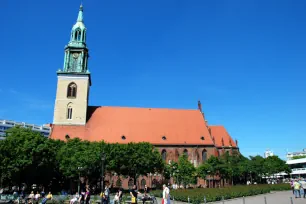
Berlin’s rather short history goes back to the thirteenth century, when the towns of Berlin and Cölln – which merged in 1307 to form what is now known as Old Berlin – were still independent. There were six churches within the boundaries of those two towns, two of which still exist: the Nikolaikirche (St. Nicholas Church) and the Marienkirche (St. Mary’s Church).
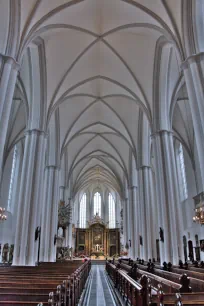
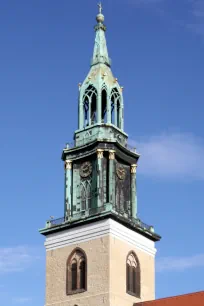
The Nikolaikirche is the oldest church, originally built in 1230. It is now at the heart of a rebuilt historic quarter, the Nikolaiviertel. The Marienkirche was built about forty years later at the center of a new district laid out around the Neuer Markt (new market).
The church
Today Marienkirche stands isolated on a large square at the foot of the TV Tower, but in the Middle Ages the church was completely surrounded by buildings. None of these however survived. The whole neighborhood, known as Marienviertel (St. Mary’s Quarter), was obliterated during the war and only the church was repaired; all the other buildings were razed.
Exterior
The brick building we now see stems from the late fourteenth century, when the original church from 1270 was rebuilt and expanded after two fires – one in 1376 and another one in 1380 – had caused significant damage.
The tower was only completed a century later, sometime after 1490. Its wooden steeple regularly fell prey to fire, so in 1790 it was replaced by a copper version created by Carl Gotthard Langhans, a Prussian architect who is best known for his design of the Brandenburg Gate. The spire was designed in a Gothic style with references to Classical and Baroque architecture. The bronze doors of the main, west portal are much more recent than they appear; they were created in 1970 by Achim Kühn.
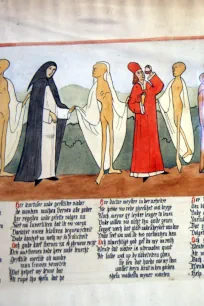
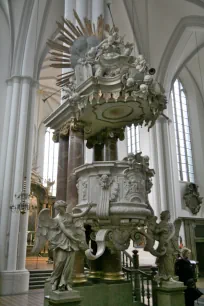
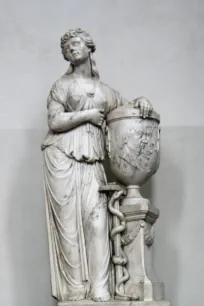
Interior
The Gothic church has a rectangular floor plan with six bays. It is divided into three aisles and features a rib-vaulted ceiling.
One of the highlights inside the church is the Totentanz (Dance of Death), a wall painting in the vestibule, right below the bell tower. The faded painting, twenty-two meters long and two meters high, was originally created at the end of the fifteenth century to commemorate the plague of 1484. It shows Death – a skin-and-bones figure with a white sheet over his shoulders – inviting people from all classes of society to a dance, a reminder that all are equal before death. The painting was rediscovered in 1860; for centuries it had been covered under whitewash.
The white-painted walls of the church’s main hall are adorned with plenty of monuments, paintings and carved reliefs, some of which originally belonged to nearby churches destroyed during the War.
The magnificent Baroque pulpit dates from 1703 and was created by sculptor Andreas Schlüter. The wooden pulpit is clad in alabaster and exuberantly decorated with carved reliefs and statues of angels and cherubs. The altar in the chancel is also Baroque in style. It was created in 1762 following an earlier design by architect Andreas Stüler. The large triptych was painted by Bernhard Rode. In front of the chancel stands a baptismal font, probably made in 1437. Its bowl, with carved reliefs of Christ, Mary and the twelve apostles, is supported by four dragons.
Several monuments adorn the walls of the side aisles and chancel. One of the most beautiful is the marble tomb of field marshal Otto Christoph von Spar, built in 1662 by the Flemish sculptor Artus Quellinus the Elder. Nearby is the impressive monument for Ehrenreich von Röbel, created in the seventeenth century from sandstone.
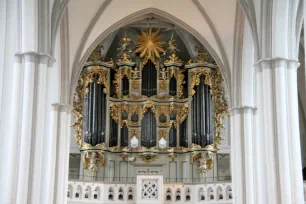
One of the most elegant monuments in the church is a marble sculpture created around 1800 for minister Friedrich Roloff and his wife Dorothea Eleonora. The monument’s design was inspired by classical Roman sculpture.
The organ on the west wall is a masterpiece built in 1721-1722 by Joachim Wagner. The screen was created in 1723 by Gottlieb Glume. The organ was renovated and partially reconstructed in 2002 by Daniel Kern.
- Next: Fernsehturm
- More Sights & Attractions in Berlin

